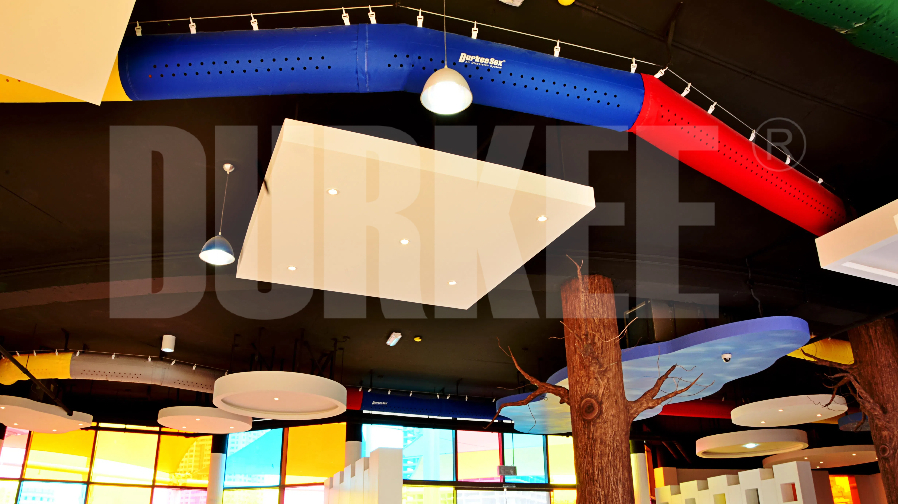 How Durkee Smart HVAC Innovations Take Center Stage at China Refrigeration 2025
How Durkee Smart HVAC Innovations Take Center Stage at China Refrigeration 2025
 Advantages and Prospects of Cloth Air Ducts
Advantages and Prospects of Cloth Air Ducts
 Fabric Duct: Innovator of Flexible Ventilation Systems
Fabric Duct: Innovator of Flexible Ventilation Systems
Introduction:
In the dynamic world of construction, contractors face numerous challenges, from tight schedules and budgets to sourcing skilled labor and high-quality materials. Among these, managing air distribution systems should simplify, not complicate, the process.
Traditional sheet metal ducts, while familiar, come with significant drawbacks: they are bulky, space-consuming, and can become prohibitively expensive, especially during economic downturns. The HVAC ducting system has responded with an innovative alternative: fabric duct, also known as cloth air duct or duct sock.
This article delves into how fabric ductwork is transforming construction projects. It explains why they might be the perfect solution for your next build, aligning with the growing demand for sustainable construction materials and energy-efficient buildings.

Fabric ducts offer unparalleled flexibility and customization, allowing them to be tailored to the specific needs of a building. This adaptability stands in stark contrast to the rigidity of traditional metal HVAC air ducts, offering more installation options and better integration with the building's design, which is particularly beneficial for projects seeking a competitive edge in construction.
One of the primary benefits of flexible fabric duct socks for contractors is their ease of installation. Flexible ducts can be maneuvered around obstacles, allowing for installation in tight or awkward spaces, which is particularly beneficial for retrofit projects or areas with complex structures. This flexibility reduces the time and labor costs associated with installation, providing a significant advantage over metal rigid ductwork that requires more time and skill.
By occupying less space than galvanized steel metal ducts, fabric ducts sock free up valuable real estate within a building. This is especially crucial for projects with limited space, allowing for more efficient use of the building's footprint.
Fabric ducts are generally more cost-effective than metal ductwork, especially during economic downturns. They are not only cheaper to purchase but also have lower maintenance costs, making the cloth ductwork a financially prudent choice and a key factor in sustainable construction.
Fabric ducts are made from recyclable materials, reducing their environmental impact and aligning with the growing trend of sustainable construction and eco-friendly building practices. This feature is particularly appealing to clients and investors seeking green building initiatives.
Fabric ducts provide a wider range of design options, allowing them to blend seamlessly with the building's aesthetic. This enhances the overall visual appeal of the project, adding value to the finished buildings.
The insulating properties of fabric duct air sock are superior to those of metal duct work, reducing energy loss and improving energy efficiency. This not only saves on operational costs but also contributes to a greener building, which is an important consideration for modern construction projects.
Flexible ducts can absorb noise and vibration from the HVAC air duct system, leading to a quieter operation. This is an important consideration for contractors looking to enhance the comfort of the living spaces they are constructing or renovating.
Contractors often encounter hard-to-reach areas in buildings where traditional ductwork is difficult to install. Flex ducts are very easy to bend around roof rafter components in the attic, floor joists in the basement, as well as other difficult areas in the framing of a building.
Maintenance and replacement of flexible ducts are relatively simple tasks. Since they are lightweight and easy to handle, cleaning or replacing them does not require a significant amount of labor or specialized tools. This makes them a cost-effective air flows solution for long-term HVAC heating and cooling system management.
In the dynamic construction industry, needs can change rapidly. Fabric ducts' flexibility allows for quick adjustments to accommodate these changes, ensuring projects stay on track and within budget.
Fabric ducts are less prone to accumulating dust and bacteria, helping to maintain better indoor air quality. This contributes to a healthier and safer environment for occupants.

In conclusion, fabric ducts offer a multitude of advantages that make them an attractive option for construction projects. Their unique benefits not only enhance project quality and efficiency but also provide contractors with a competitive edge while being environmentally responsible. As the demand for sustainable and energy-efficient buildings grows, fabric ducts are poised to become an indispensable part of the construction landscape. Embracing fabric ducts sock is a step towards a more innovative, cost-effective, and eco-conscious future in the construction industry.